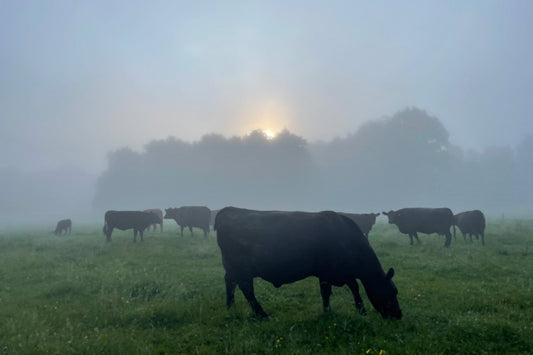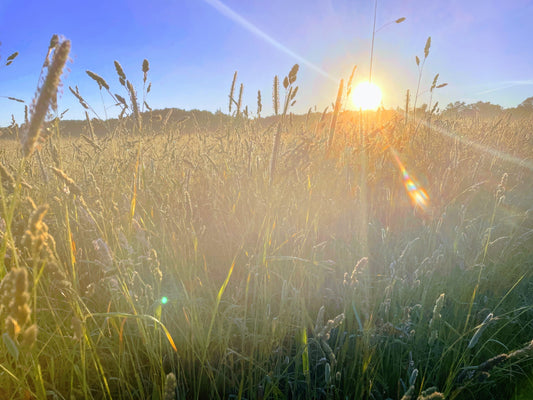Ashes to Earth: A Look at the Environmental Impact of Final Resting Choices
Share
When a loved one passes, we face both emotional and practical decisions. For many, choosing what happens to their body — or their ashes, also known as cremains — is more than a logistical matter. It’s also an ethical and environmental one.
In recent years, more people are asking: “What’s the ecological impact of my final resting place?”
At Farmstead Scattering Garden, we offer a mail-in ash scattering service on our fifth-generation working farm. We chose this model because it reflects our values — land stewardship, simplicity, and legacy. And for those seeking a low-impact, nature-based option, scattering can offer one of the gentlest footprints on the planet.
But how does ash scattering compare to other common end-of-life options? Let’s take a closer look.
Traditional Burial: Honoring the Past, But at a Cost
For generations, traditional burial has been the most common choice. It typically includes embalming, a hardwood or metal casket, a concrete burial vault, and a perpetual plot of land in a cemetery.
Environmental costs:
- ~1.6 million tons of reinforced concrete used annually (U.S.)
- 4.3 million gallons of embalming fluid released into the environment
- Land permanently removed from natural ecosystems
- Ongoing mowing, watering, and chemical treatment of lawns
Cremation: A Lighter Footprint, But Not Footprint-Free
Cremation now accounts for more than half of U.S. dispositions — and for good reason. It’s often more affordable, more flexible, and requires no burial plot. But it still carries its own ecological impacts.
Environmental costs:
- Between 400 and 600 pounds of CO₂ emitted per cremation
- Air pollutants, including mercury (from dental fillings) and dioxins
- High energy use (natural gas or electricity)
Ash Scattering: A Gentle Return
Scattering cremated ashes — also called cremains — on land or water is one of the lowest-impact options available, particularly when done thoughtfully and without the addition of urn burial or monument construction.
At Farmstead Scattering Garden, we receive ashes by mail, scatter them by hand, and return photos and a map of the scattering spot. There is no permanent land disturbance, no synthetic materials, no chemicals, and no cemetery infrastructure.
Why scattering on a working farm is different:
- No single-use urns or vaults
- No ongoing landscaping or irrigation
- Ashes become part of a living ecosystem — fields, meadows, or wooded glens
- Our land is used daily and regeneratively; your loved one’s ashes contribute to life, not lawn
Environmental Impact Comparison Chart

Lower-Impact Alternatives: What Else Is Out There?
If you’re looking for the lowest possible environmental impact, here are some other emerging options:
- Green burial: No embalming, biodegradable containers, no vaults; often in conservation cemeteries.
- Alkaline hydrolysis (aqua cremation): Uses water and pressure instead of flame, with up to 90% less CO₂ emissions.
While these are promising, they may not be available in all states, can be expensive, and still often require travel and planning.
A Quiet Legacy
At the heart of our work is this belief: Where and how we return someone to the earth matters. For families who cannot be present, our ash scattering service offers a respectful, regenerative choice — one that lets nature do what it does best: remember, renew, and carry life forward.
If your family values simplicity, sustainability, and a connection to the land, scattering ashes on a working farm might be the gentle answer to the question so many families ask: what to do with human ashes.
To learn more about our environmentally conscious scattering options for humans and pets, visit www.farmsteadscattering.com.
Resources:
- TNO (Netherlands Organisation for Applied Scientific Research), 2010: Compared environmental impacts of burial, cremation, and resomation.
- Environmental Impact of Funerals: Life Cycle Assessment (2017), Australia: Compared emissions and resource use across deathcare methods.
- Green Burial Council: Aggregated data on resource use in U.S. funeral practices.
- BBC Future & National Geographic (2020–2023): Journalistic syntheses of deathcare environmental costs.
- greenburialcouncil.org/disposition-statistics-media.html
- bbc.com/future/article/20230821-how-to-plan-a-sustainable-funeral




